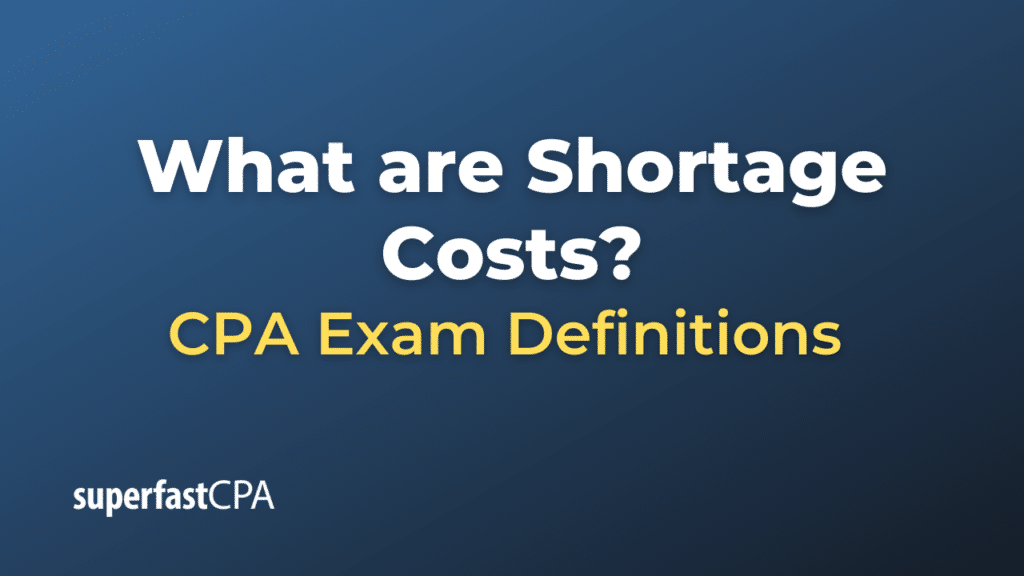Shortage Costs
Shortage costs, often referred to as stockout costs or out-of-stock costs, are costs associated with not having enough inventory to meet demand. When a business runs out of a product or cannot deliver a service due to lack of resources, various direct and indirect costs can arise. These costs can be tangible, such as lost sales, or intangible, such as damage to the company’s reputation.
Shortage costs can be classified into two main categories:
- Direct Shortage Costs: These are immediate and tangible costs related directly to the stockout.
- Lost Sales: If a customer intends to buy a product but it’s unavailable, the business loses out on that revenue.
- Expedited Orders: To quickly restock, a company might have to place emergency orders with suppliers, which often come at a premium price or higher shipping costs.
- Backorder Costs: If a company decides to take orders for out-of-stock items to be fulfilled later, there can be administrative costs, extra shipping fees, or other associated costs with fulfilling these orders later.
- Indirect Shortage Costs: These are less tangible and might have long-term implications.
- Customer Dissatisfaction: A stockout can frustrate customers, leading to a negative shopping experience.
- Loss of Customer Loyalty: Frequent stockouts might drive customers to competitors, leading to lost future sales.
- Reputation Damage: Consistent inability to meet demand can damage a company’s reputation, making it harder to attract new customers or retain existing ones.
- Administrative Hassles: Dealing with stockouts can involve a lot of time and effort, from communicating with customers to handling complaints.
Example of Shortage Costs
Let’s walk through a hypothetical scenario involving a small business and the implications of shortage costs.
Scenario: FreshBite Juice Bar
FreshBite is a popular juice bar known for its organic and fresh fruit juices. They’ve recently introduced a new flavor, “Tropical Twist,” made from a blend of mango, pineapple, and passion fruit. The promotional campaign for the new flavor was very effective, leading to a surge in demand.
However, FreshBite’s management underestimated this demand and didn’t stock enough passion fruit, which is a critical ingredient for the “Tropical Twist” flavor.
Consequences of the Shortage:
- Direct Shortage Costs:
- Lost Sales: Over the weekend, 50 customers specifically came for the “Tropical Twist” but left without making a purchase due to its unavailability. Assuming each juice sold for $5, this resulted in a direct loss of $250.
- Expedited Orders: To cater to the continued demand, FreshBite placed an emergency order for passion fruit from a nearby supplier. This expedited order came with an additional cost of $40 compared to their regular shipments.
- Indirect Shortage Costs:
- Customer Dissatisfaction: Among the 50 customers who couldn’t buy the “Tropical Twist,” 10 were first-time visitors who had heard about the new flavor from friends. Their first experience at FreshBite was negative.
- Loss of Customer Loyalty: Out of the 50 disappointed customers, 15 decided they would rather go to another juice bar next time since they couldn’t trust FreshBite to have what they wanted.
- Reputation Damage: Three customers left negative reviews online, mentioning the stockout. These reviews can dissuade potential new customers from visiting.
- Administrative Hassles: Employees at FreshBite had to spend extra time explaining the situation to customers, handling complaints, and updating promotional materials to indicate the temporary unavailability of the “Tropical Twist.
Financial Implications:
- Direct Costs: $250 (lost sales) + $40 (expedited order) = $290
- Indirect Costs: Difficult to quantify in exact monetary terms, but these could exceed the direct costs over time, especially if some customers permanently switch to competitors or if the negative reviews deter potential new customers.
This example showcases how shortage costs can have both immediate and long-term implications for a business. Even though FreshBite faced a direct financial impact of $290, the indirect costs could have a lasting effect on their brand and customer loyalty. Proper inventory management and forecasting are crucial to prevent such situations.













